ASRock X99 OC Formula/3.1 And Fatal1ty X99 Professional/3.1
ASRock’s latest X99 boards fill the budget gap between the high-end and premium motherboard markets, but do their features justify the extra price?
Why you can trust Tom's Hardware
Benchmark Results
Update: We’ve made a few changes. Asus provide us with the Rampage V Extreme 3.1 as a sample board with which to conduct our memory overclocking. We benchmarked it to verify that it was better than our already-favorite overclocking board, the X99-Pro. Our testing proved those claims true and those results are still provided here. However, we did not have permission to review the board, so we have removed a couple of our comparative comments on it until we have a chance to review it in full. In the interest of full disclosure, we noted the higher price of the Asus board, and some of what that higher price buys.
Synthetic Benchmarks
ASRock’s “Multi Core Enhancement” overclocking function is disabled by default, assuring a fair benchmark run without manual intervention. Without any overclocking snuck into the evaluation, both the X99 OC Formula/3.1 and Fatal1ty X99 Professional/3.1 produce the anticipated levels of 3DMark and PCMark performance.
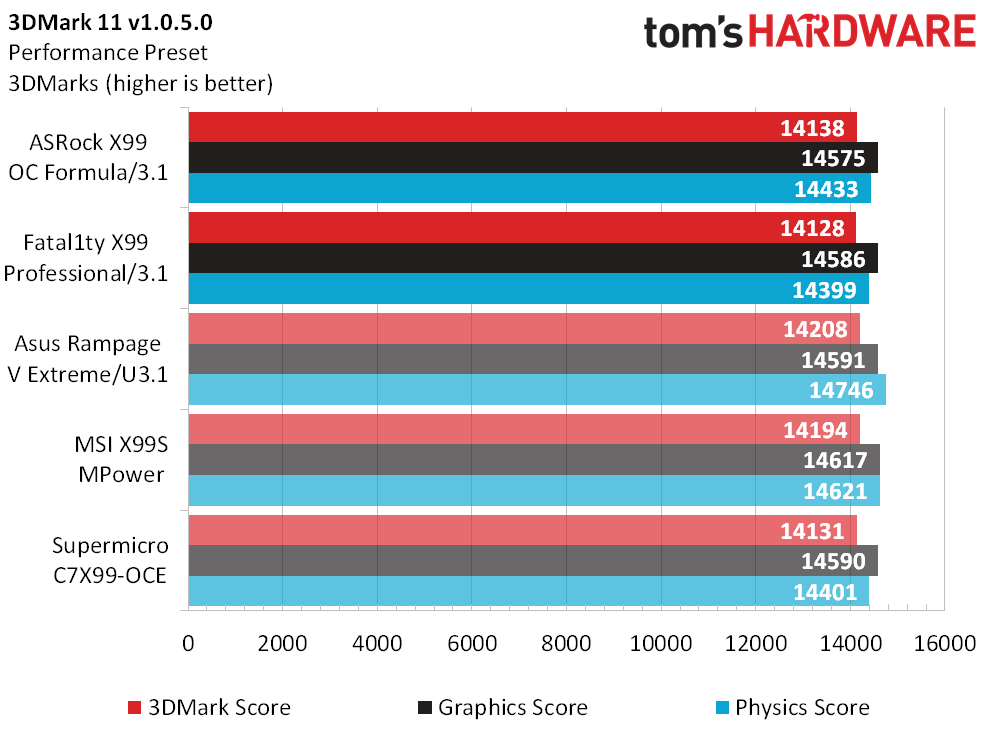
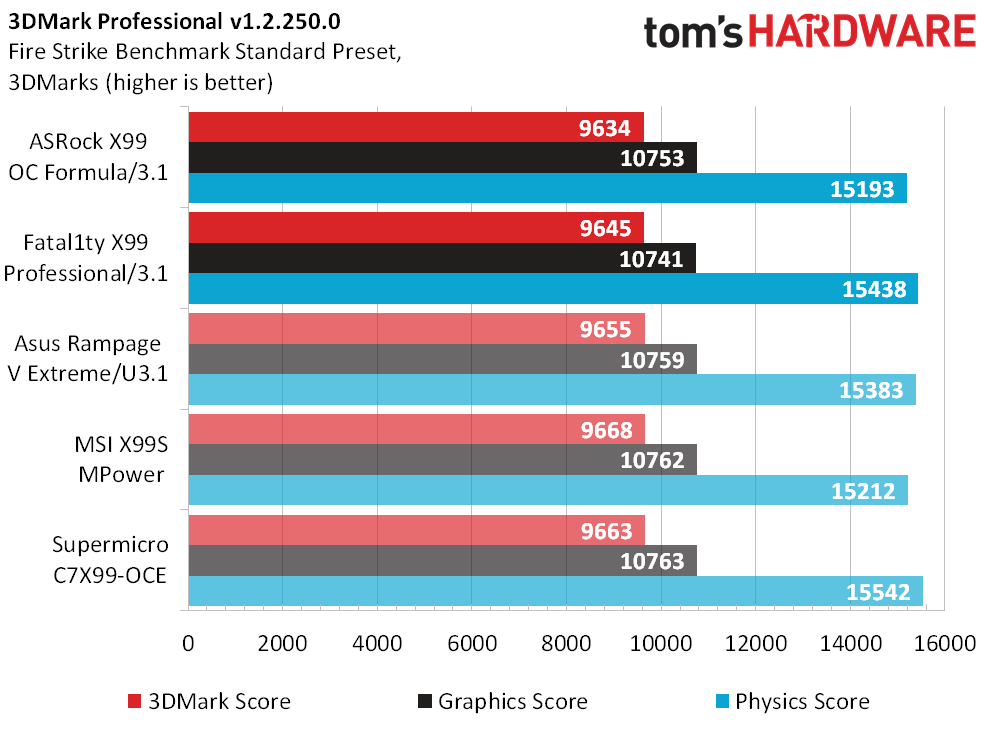

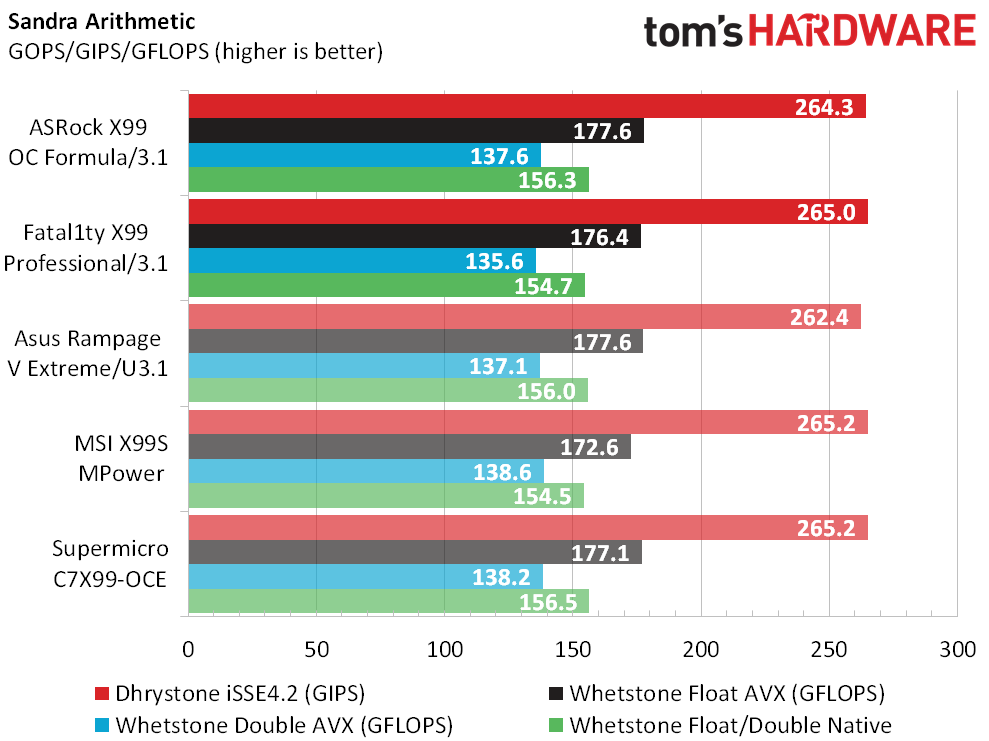
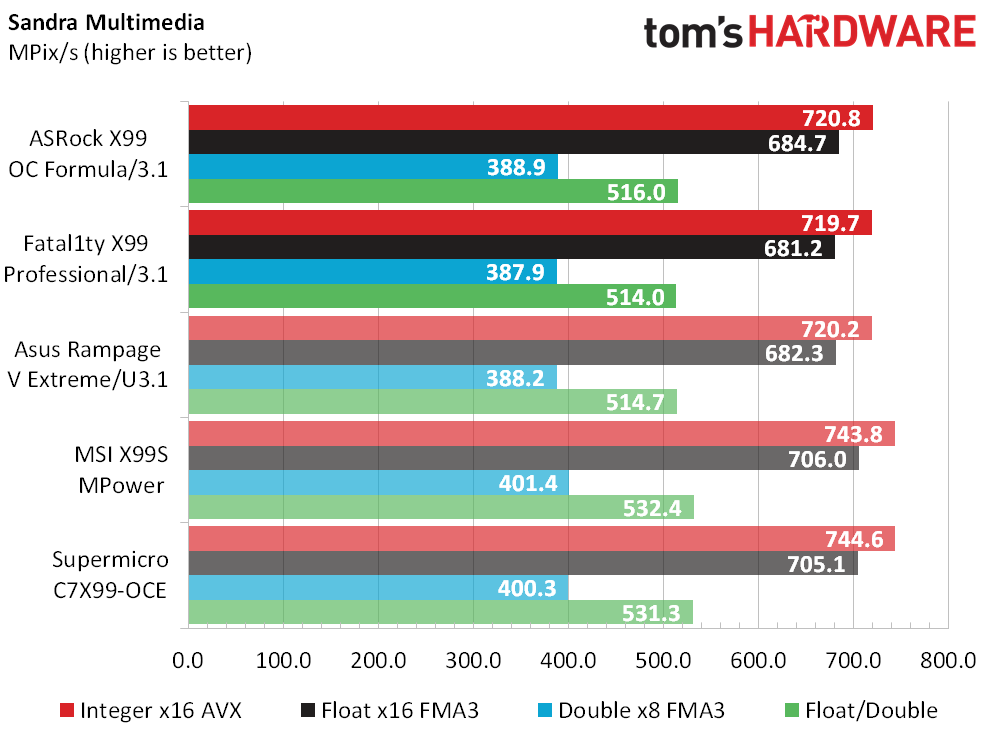
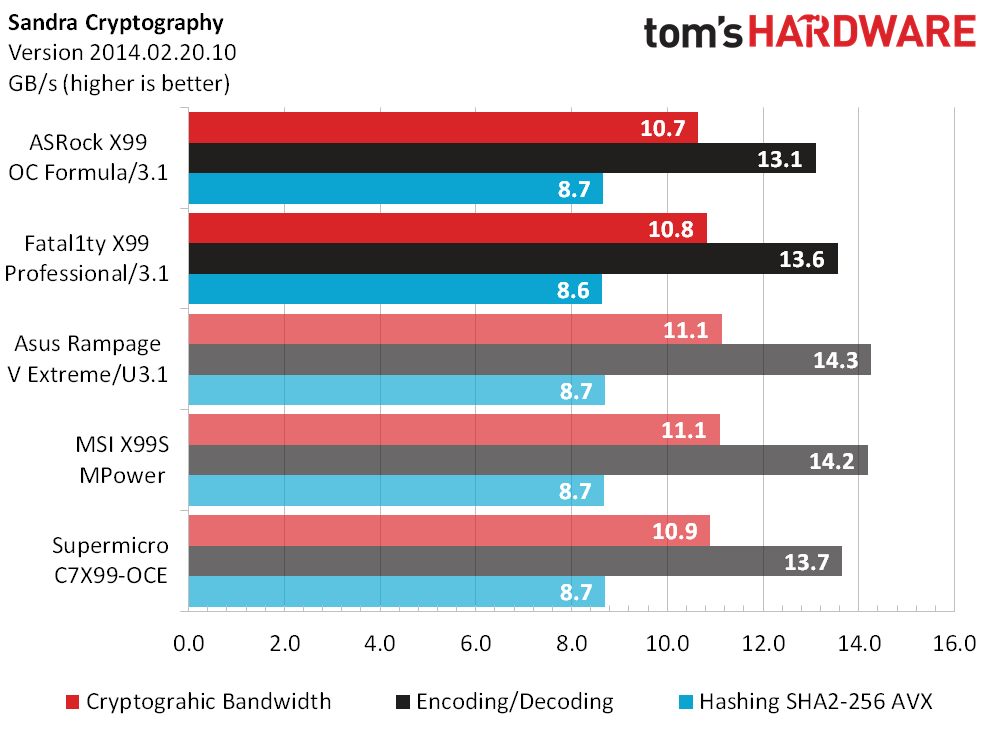
Secondary and tertiary memory timings are the only optimizations most manufacturers can find for Intel’s highly-integrated platforms, without getting called out for cheating. Asus and MSI integrated this boost through default firmware settings. Bandwidth also boosts Sandra’s Cryptography test, particularly in Encoding/Decoding turnaround times.
Gaming Benchmarks
Grid 2 benefits slightly from improved memory performance, but only the X99S MPower returned a noticeably higher result, and that gain is only noticeable in a chart.
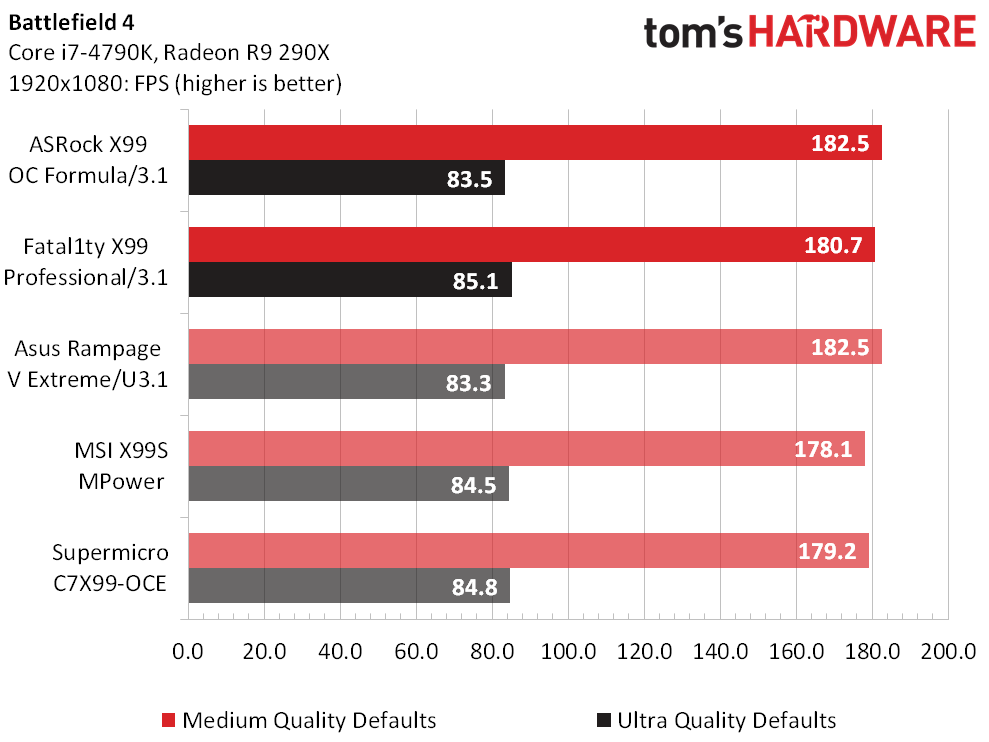
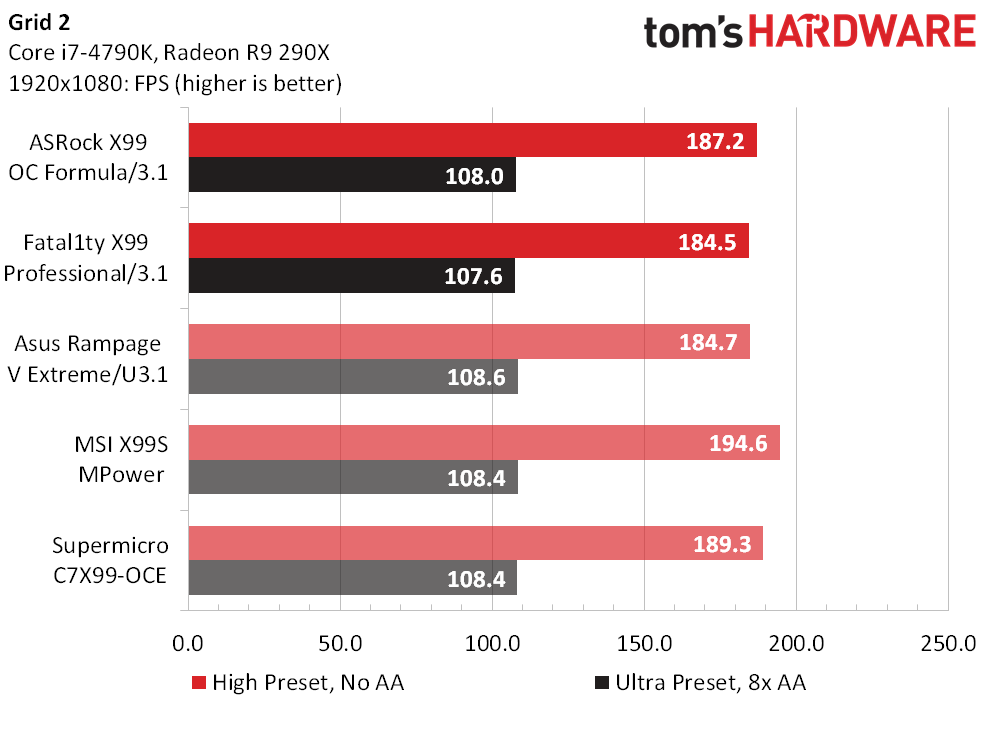
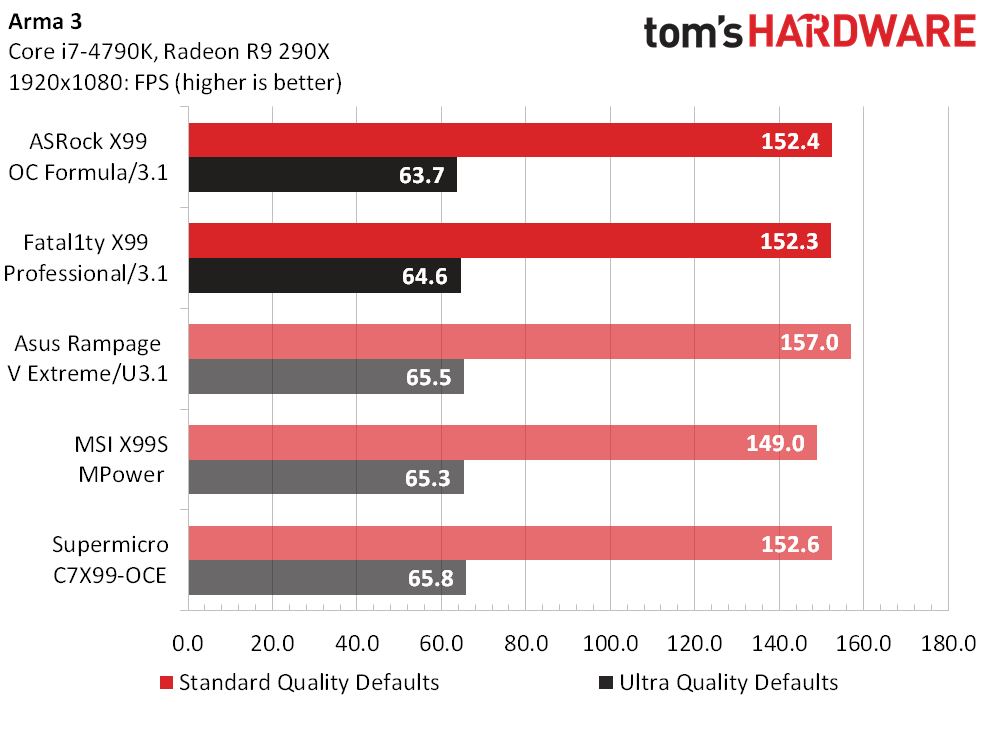
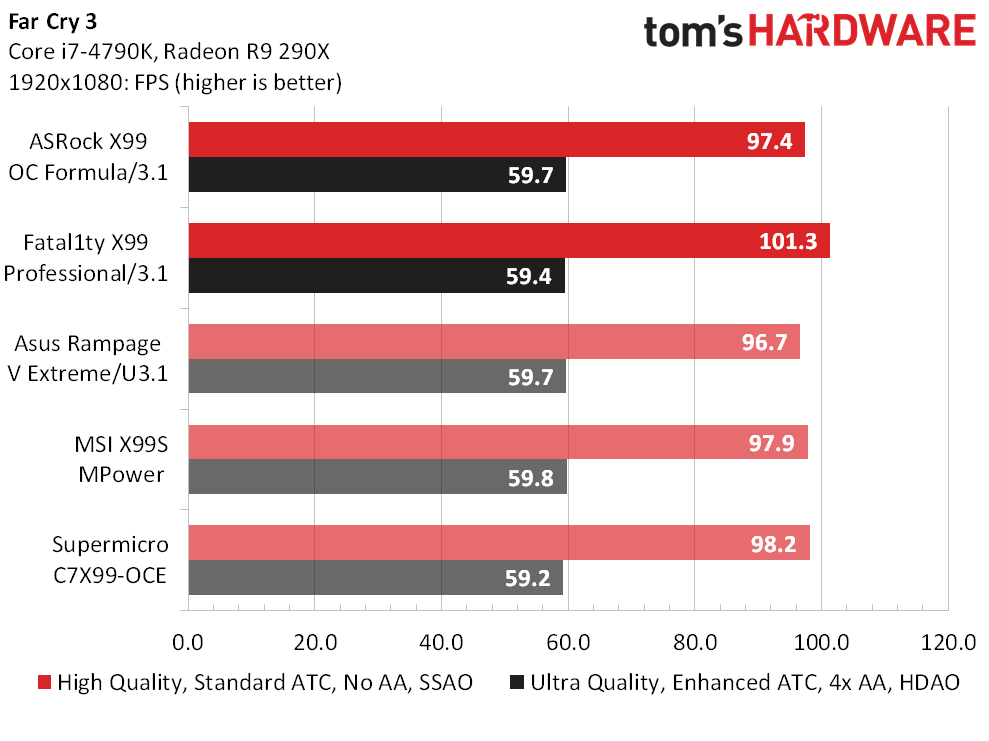
The Asus had a similarly small victory at the lower test settings of Arma 3. Both the X99 OC Formula/3.1 and Fatal1ty X99 Professional/3.1 produce normal frame rates across this suite.
Application Benchmarks
Lower is better in timed benchmarks, but normalization is a good thing when all of the boards are paired with the same CPU, GPU and DRAM.
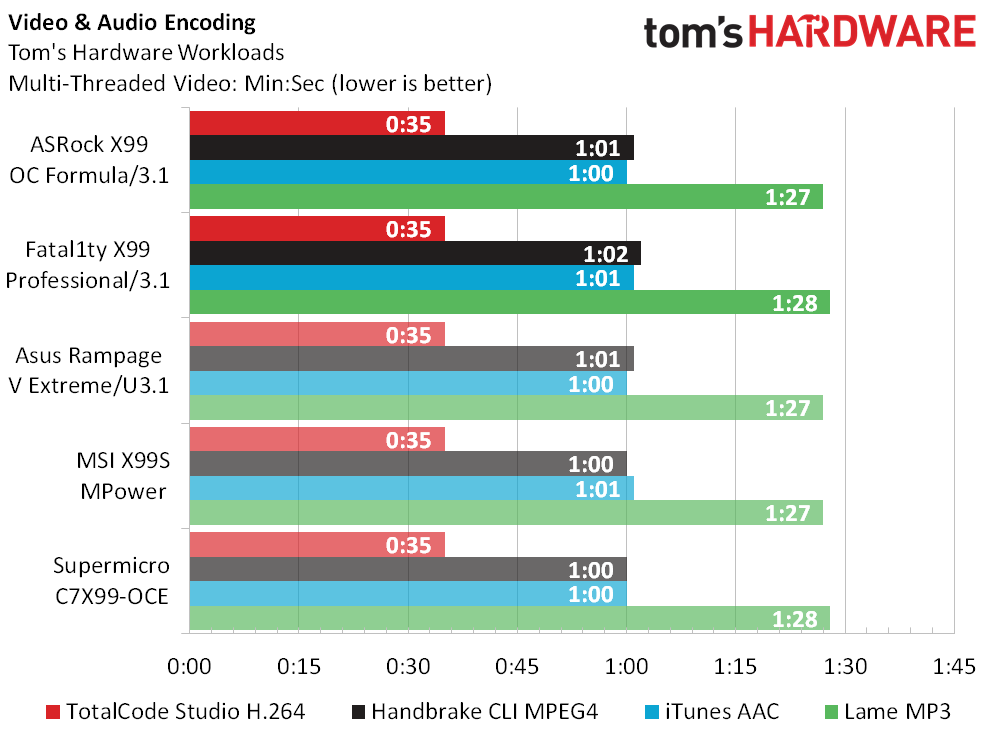
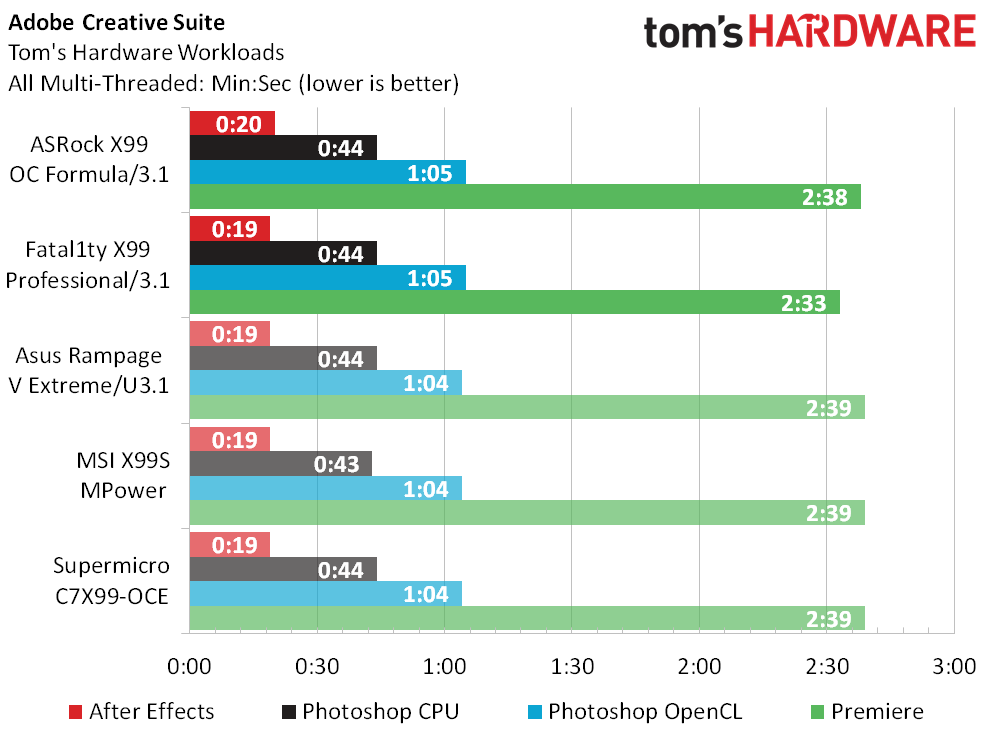
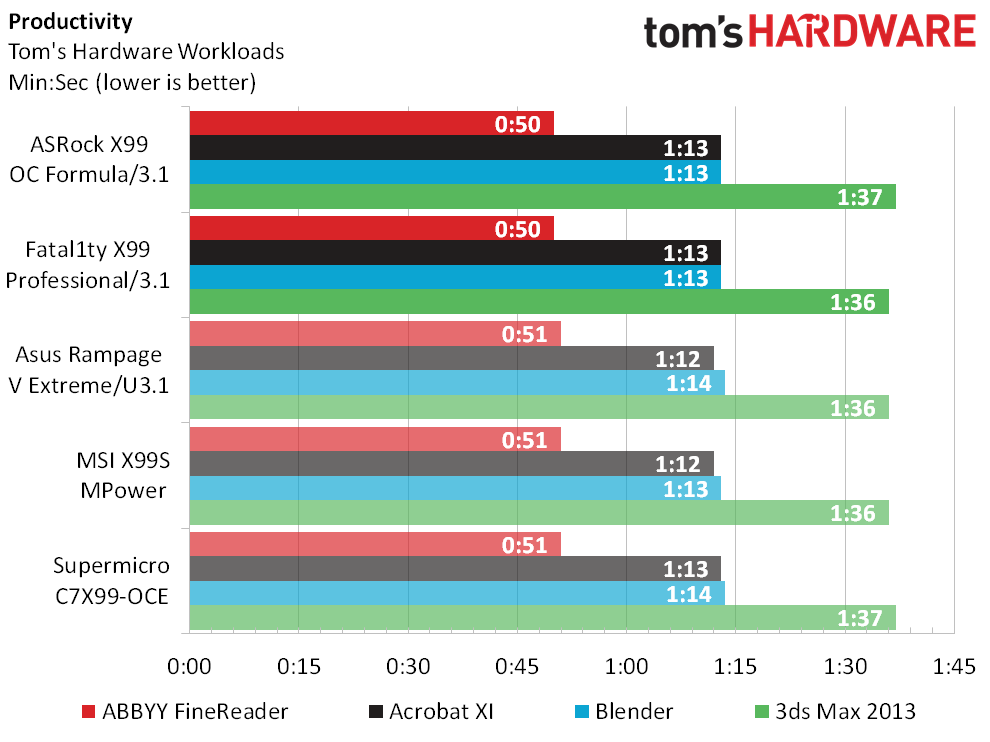
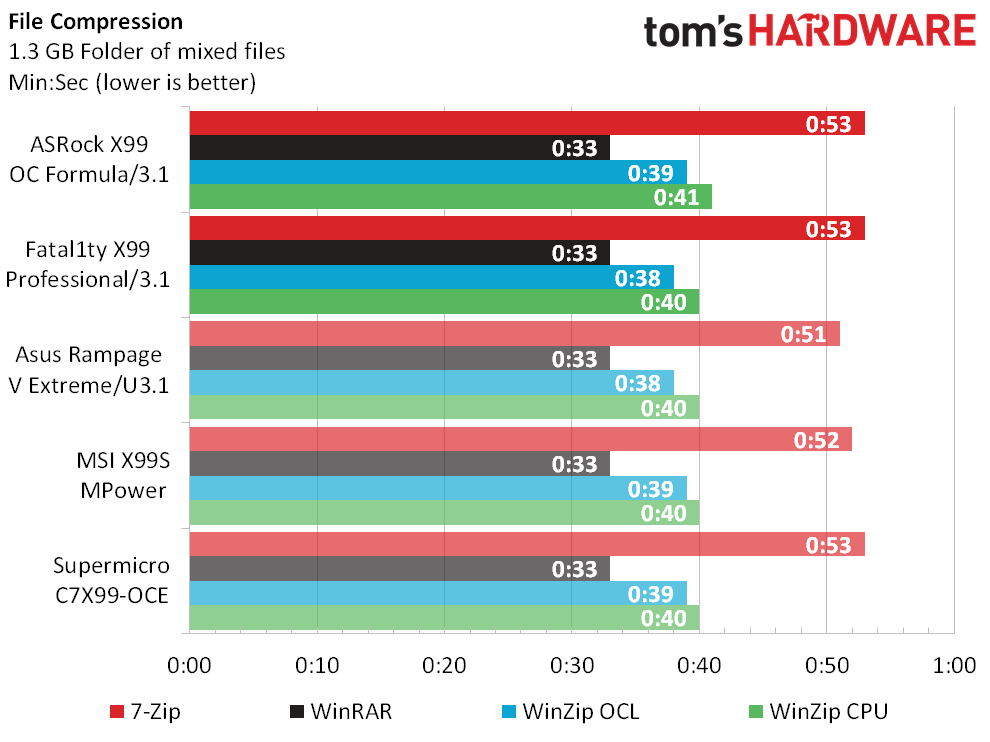
Fortunately, all of the X99 motherboards we’ve tested are on average, well, average.
Get Tom's Hardware's best news and in-depth reviews, straight to your inbox.
Power, Heat And Efficiency
The X99 OC Formula/3.1 idled down a little better than we expected, and lead the high-end motherboard range in power consumption. The Fatal1ty X99 Professional/3.1 also scored well.
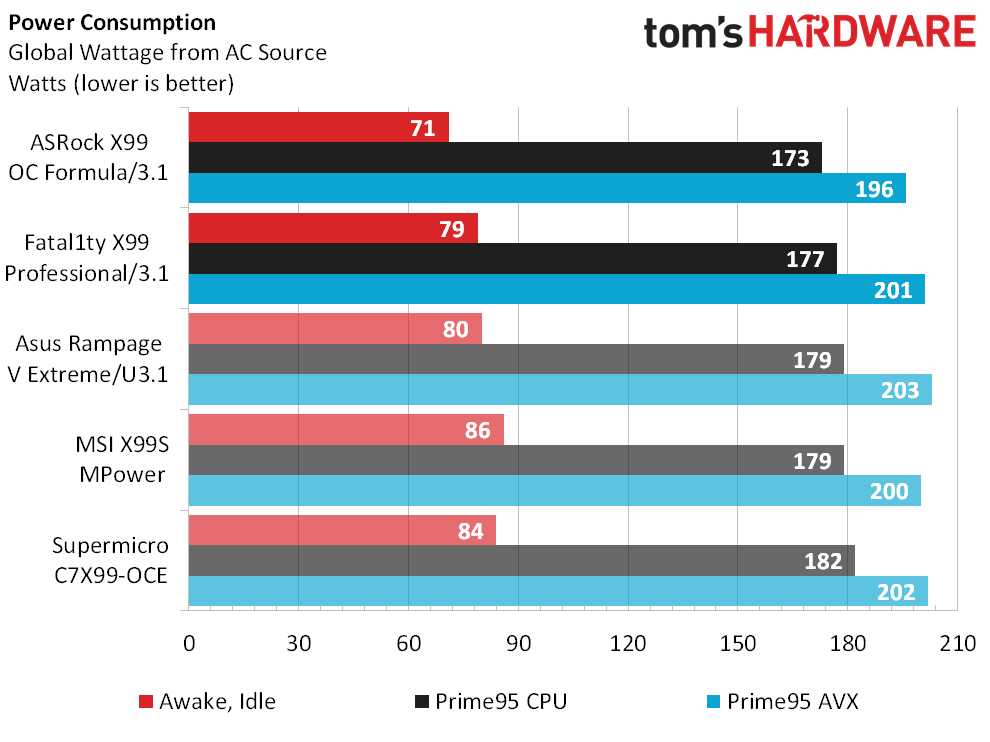
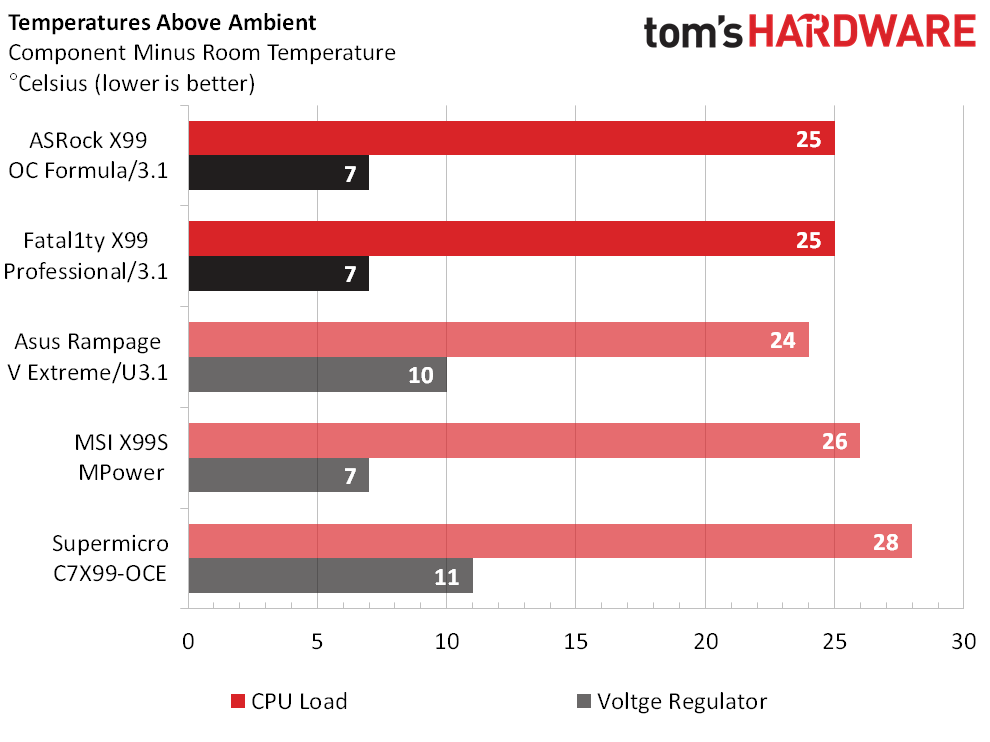
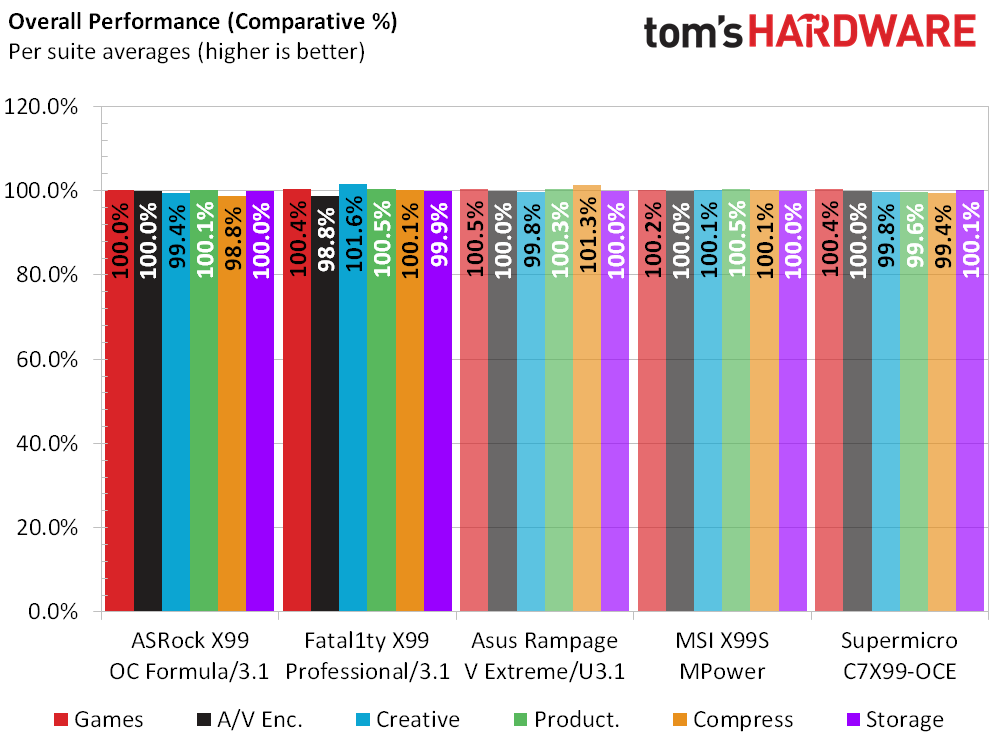
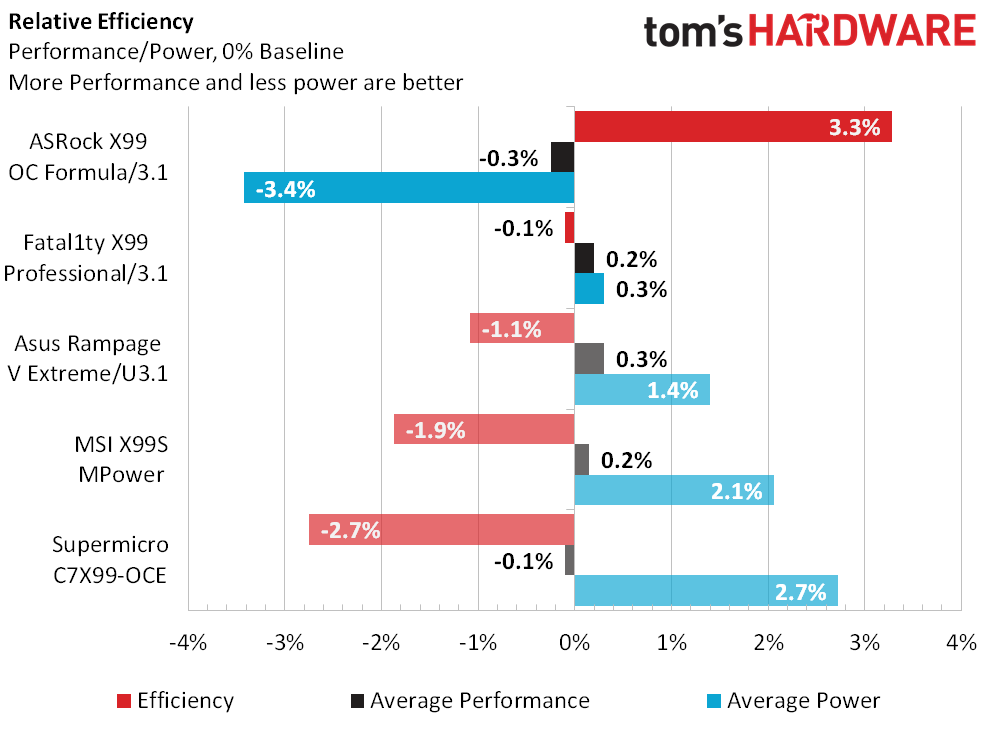
The problem for high-end boards in our efficiency chart is that performance and power are calculated against an average of all 15 X99 motherboards that we’ve reviewed. Cheaper models that have fewer features and controllers tend to consume less energy, yet ASRock still pulls out a noticeable over-average efficiency score in the X99 OC Formula/3.1. The Fatal1ty X99 Professional/3.1 beats the rest of the high-end field.
-
obababoy That gold is beautiful! If X99 wasnt a complete waste of a gamers money I would upgrade my z97 setup.Reply -
MonsterCookie I am wondering whether these newer Intel chipsets do actually support the VT-d extensions for virtualization?Reply
By looking at the board, it is full with PCI-e bridge chips to enhance the number of PCI lanes the CPU can address. However, this trick is a no-go with VT-d, since you need direct access to the hardware, and it cannot sit beyond a PCI-e bridge. I have similar issues with my HP Z800 due to trashy Intel chipset.
This is why I had to buy a dirty AMD FX8350, because on AMD all features are supported. Otherwise I would have not even poked an AMD system with a 10 foot pole.
Btw, Tom's.
WHY ON EARTH does that red arrow at the top of the page occupy half of my screen vertically, and it scrolls down as I scroll down the page so I cannot get rid of it at all?
You are reviewing tiny 1080p screens, so you should know that occupying 10% of the visible area with a useless arrow is not cool. -
MonsterCookie BTW, I forgot to mention that in general Killer NICs pretty much suck. On Linux they often do not work at all, which is tragicomic considering that they actually run an embedded-Linux on the cards embedded-CPU itself.Reply
Just throw in a good Intel Gigabit NIC, and that will rock with close to theoretical speed, no messing around with drivers, VM-ware, KVM and Xen recognize them too. Try to do that with a "Killer" NIC. -
Crashman Reply
No, those aren't bridge chips, they're just the electronic version of a double-pole switch. I don't know how software would even know that they're there. Unlike the bridging switches, there are no extra lanes provided, the platform always gets 40 from a 40-lane CPU or 28 from a 28-lane CPU, and these become "fixed" as soon as the device is installed. The PCH lanes are fixed without having any device installed..16348993 said:I am wondering whether these newer Intel chipsets do actually support the VT-d extensions for virtualization?
By looking at the board, it is full with PCI-e bridge chips to enhance the number of PCI lanes the CPU can address. -
goinginstyle Another sucktastic review. Of course no matter the price ASRock will receive an award, just like MSI always does even with stability and crap software and EFI controls. What is your problem with Asus? You pretended to review the Ramage V Extreme board but really did not go into detail on it. Seems like you have a personal issue with Asus, especially noticing the lack of reviews in the last six months. The Rampage V is a much better product than the two ASRock boards and your opinion about enthusiasts wanting to save money and go with ASRock is laughable at best. You have no clue what enthusiasts want or desire. The two ASRock boards are a joke. Just read the forums and other reviews.Reply -
Crashman Reply
Asus sent the Rampage V Extreme specifically for O/C testing, having voiced concern that our value analysis doesn't account for the extra time and expense they put into firmware and software development. A full review would require us to buy our own sample, and we haven't gotten there yet.16353633 said:What is your problem with Asus? You pretended to review the Ramage V Extreme board but really did not go into detail on it. Seems like you have a personal issue with Asus, especially noticing the lack of reviews in the last six months. -
tpovic THIS SHOULD BE UNDER ALL MOTHERBOARD TESTSReply
so maybe in a few years us not buying this crap they turn around and inovate!
"As we all know some (if not all) Apple laptops come without a CD drive, some do not have a Ethernet jack (WiFi only), obviously everyone heard about the new laptop with USB 3.1 being the only jack on the laptop.
I am not saying Intel and motherboard manufacturers need to go to that extreme, but we have reached a point where removing some of these old ports will allow manufacturers to save money and pass them to the buyer.
Is there really a need for a PS/2 port on a performance motherboard? Why not remove all the USB 2.0 ports and maybe add 2 more USB 3.0 ports.
I recently purchased a MSI motherboards called GAMING 5, it is a gaming motherboard (duhh), marketed towards people on the gaming/performance side. Obviously anyone buying this board in the retail store is buying it with an intent to play games, and almost no one who games in 2015 uses a VGA or DVI ports, it also has PS/2 port.
I am paying for these useless features that regular people almost no longer use, let alone gamers or people who are into PC building. You can include a HDMI to VGA or DVI adapter just in case someone out there still needs them.
I think they need to start removing some of the legacy ports and chips and make boards cleaner, cheaper and more affordable to manufacture and buy." -
RedJaron Reply
Yes. A lot of gamers still refuse to use anything except a PS/2 keyboard. These are the same type of people who would shell out big money for an extreme gaming rig.16355398 said:Is there really a need for a PS/2 port on a performance motherboard?
Because the X99 chipset is limited to six USB3 ports. Often this comes as four ports on the back and one for the front panel header. Adding more USB3 requires an additional USB controller chip and that costs more money. Besides, USB2 handles basic peripherals such as keyboards, mice, printers, scanners, etc more than adequately, so removing them is unnecessary. USB3 is only necessary for external high-speed storage at the moment so there's no reason to think your keyboard and mouse must use USB3.16355398 said:Why not remove all the USB 2.0 ports and maybe add 2 more USB 3.0 ports.
I said the same thing in my last review regarding VGA ports. I don't think they're necessary on a Z97 or X99 board specifically meant for power users. Having a DVI, HDMI, or DisplayPort still makes sense because even though you'll likely have a dGPU, at times you'll need to use the integrated video, say for troubleshooting. I've already covered PS/2.16355398 said:I recently purchased a MSI motherboards called GAMING 5, it is a gaming motherboard (duhh), marketed towards people on the gaming/performance side. Obviously anyone buying this board in the retail store is buying it with an intent to play games, and almost no one who games in 2015 uses a VGA or DVI ports, it also has PS/2 port.
Your situation does not apply to everybody, nor even most people. If you think premium mboards are expensive now, imagine how pricey they'd be if they had to make 10 versions of the same board just to cater to all the people who might use it. Desktop mboards have to have a LOT of different features because the same model board will often be used for many different things.16355398 said:I am paying for these useless features that regular people almost no longer use, let alone gamers or people who are into PC building. You can include a HDMI to VGA or DVI adapter just in case someone out there still needs them.
I think they need to start removing some of the legacy ports and chips and make boards cleaner, cheaper and more affordable to manufacture and buy." -
tpovic Reply16359804 said:
Yes. A lot of gamers still refuse to use anything except a PS/2 keyboard. These are the same type of people who would shell out big money for an extreme gaming rig.16355398 said:Is there really a need for a PS/2 port on a performance motherboard?
Because the X99 chipset is limited to six USB3 ports. Often this comes as four ports on the back and one for the front panel header. Adding more USB3 requires an additional USB controller chip and that costs more money. Besides, USB2 handles basic peripherals such as keyboards, mice, printers, scanners, etc more than adequately, so removing them is unnecessary. USB3 is only necessary for external high-speed storage at the moment so there's no reason to think your keyboard and mouse must use USB3.16355398 said:Why not remove all the USB 2.0 ports and maybe add 2 more USB 3.0 ports.
I said the same thing in my last review regarding VGA ports. I don't think they're necessary on a Z97 or X99 board specifically meant for power users. Having a DVI, HDMI, or DisplayPort still makes sense because even though you'll likely have a dGPU, at times you'll need to use the integrated video, say for troubleshooting. I've already covered PS/2.16355398 said:I recently purchased a MSI motherboards called GAMING 5, it is a gaming motherboard (duhh), marketed towards people on the gaming/performance side. Obviously anyone buying this board in the retail store is buying it with an intent to play games, and almost no one who games in 2015 uses a VGA or DVI ports, it also has PS/2 port.
Your situation does not apply to everybody, nor even most people. If you think premium mboards are expensive now, imagine how pricey they'd be if they had to make 10 versions of the same board just to cater to all the people who might use it. Desktop mboards have to have a LOT of different features because the same model board will often be used for many different things.16355398 said:I am paying for these useless features that regular people almost no longer use, let alone gamers or people who are into PC building. You can include a HDMI to VGA or DVI adapter just in case someone out there still needs them.
I think they need to start removing some of the legacy ports and chips and make boards cleaner, cheaper and more affordable to manufacture and buy."
